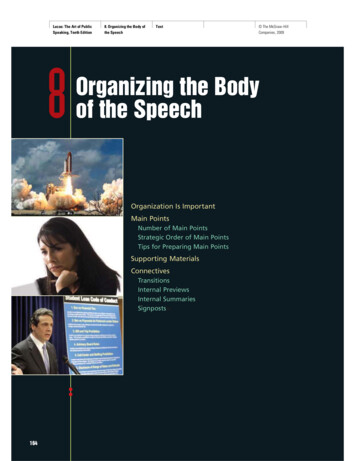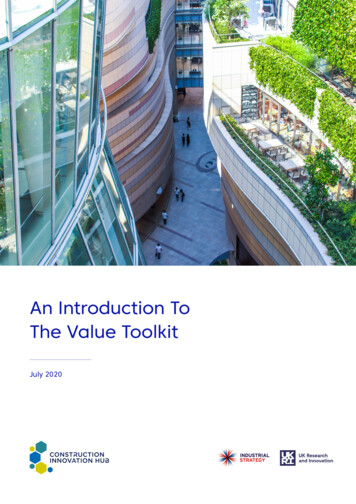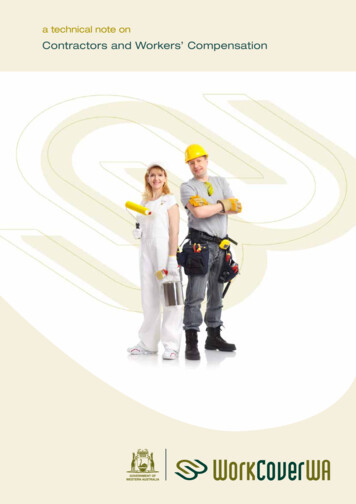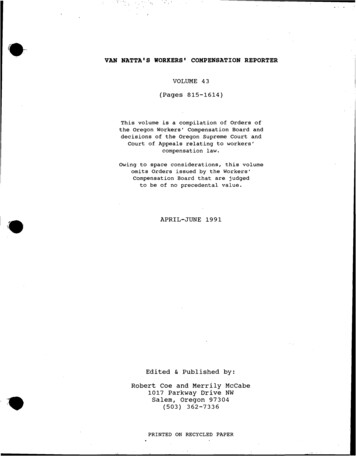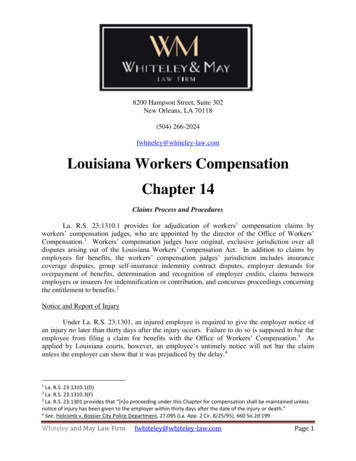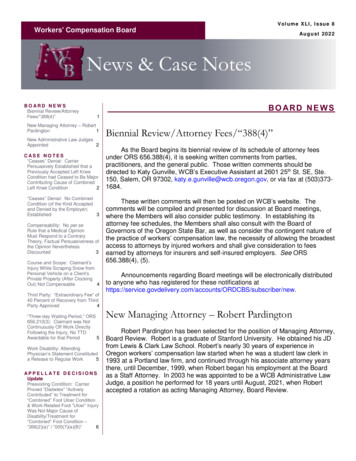
Transcription
Volume XLI, Issue 8Workers' Compensation BoardAu g u s t 2 0 2 2News & Case NotesBO ARD NEW SBiennial Review/AttorneyFees/“388(4)”B O AR D N E W S1New Managing Attorney – RobertPardington1New Administrative Law JudgesAppointed2C AS E NOTES“Ceases” Denial: CarrierPersuasively Established that aPreviously Accepted Left KneeCondition had Ceased to Be MajorContributing Cause of CombinedLeft Knee Condition2“Ceases” Denial: No CombinedCondition (of the Kind Acceptedand Denied by the Employer)Established3Compensability: No per seRule that a Medical OpinionMust Respond to a ContraryTheory, Factual Persuasiveness ofthe Opinion NeverthelessDiscounted3Course and Scope: Claimant’sInjury While Scraping Snow fromPersonal Vehicle on a Client’sPrivate Property (After ClockingOut) Not Compensable4Third Party: “Extraordinary Fee” of40 Percent of Recovery from ThirdParty Approved4“Three-day Waiting Period,” ORS656.210(3): Claimant was NotContinuously Off Work DirectlyFollowing the Injury, No TTDAwardable for that Period5Work Disability: AttendingPhysician’s Statement Constituteda Release to Regular Work5APPELLATE DECISIONSUpdatePreexisting Condition: CarrierProved “Diabetes” “ActivelyContributed” to Treatment for“Combined” Foot Ulcer Condition& Work-Related Foot “Ulcer” InjuryWas Not Major Cause ofDisability/Treatment for“Combined” Foot Condition –“266(2)(a)” / “005(7)(a)(B)”6Biennial Review/Attorney Fees/“388(4)”As the Board begins its biennial review of its schedule of attorney feesunder ORS 656.388(4), it is seeking written comments from parties,practitioners, and the general public. Those written comments should bedirected to Katy Gunville, WCB’s Executive Assistant at 2601 25th St. SE, Ste.150, Salem, OR 97302, katy.e.gunville@wcb.oregon.gov, or via fax at (503)3731684.These written comments will then be posted on WCB’s website. Thecomments will be compiled and presented for discussion at Board meetings,where the Members will also consider public testimony. In establishing itsattorney fee schedules, the Members shall also consult with the Board ofGovernors of the Oregon State Bar, as well as consider the contingent nature ofthe practice of workers’ compensation law, the necessity of allowing the broadestaccess to attorneys by injured workers and shall give consideration to feesearned by attorneys for insurers and self-insured employers. See ORS656.388(4), (5).Announcements regarding Board meetings will be electronically distributedto anyone who has registered for these notifications subscriber/new.New Managing Attorney – Robert PardingtonRobert Pardington has been selected for the position of Managing Attorney,Board Review. Robert is a graduate of Stanford University. He obtained his JDfrom Lewis & Clark Law School. Robert’s nearly 30 years of experience inOregon workers’ compensation law started when he was a student law clerk in1993 at a Portland law firm, and continued through his associate attorney yearsthere, until December, 1999, when Robert began his employment at the Boardas a Staff Attorney. In 2003 he was appointed to be a WCB Administrative LawJudge, a position he performed for 18 years until August, 2021, when Robertaccepted a rotation as acting Managing Attorney, Board Review.
Page 2WCB Board New s & Case NotesAdministrative Law Judges AppointedWCB is pleased to announce the appointment of two new AdministrativeLaw Judges, Van Quan and Katherine S. Krametbauer.Van Quan immigrated to the United States in 1980 and was raised inSpokane, Washington. She obtained her bachelor’s degree from the Universityof Oregon in 2001, and graduated from the University of Oregon School of Lawin 2005. After graduation, she worked in the Springfield area for John C.DeWenter, PC. She practiced in Workers’ Compensation Law, representinginjured workers. In 2008, she came to work at the Workers’ CompensationBoard as a staff attorney. In 2022, she will be joining the WCB HearingsDivision, Salem office, as an Administrative Law Judge.Katherine S. Krametbauer, a native Oregonian, obtained a Bachelor'sdegree from the University of San Diego before moving to the Washington, D.C.area to work and attend law school. After graduating from the CatholicUniversity of America School of Law in 2007, she clerked for a Washington D.C.Superior Court Judge, was a civil litigation associate at a general practiceMaryland law firm, and then worked as an Associate Deputy General Counsel atthe Department of Defense. Upon returning to Oregon in 2010, she joined theOregon State Bar and worked as a criminal prosecutor for the Hood RiverDistrict Attorney's office. In 2015, she joined the SAIF Corporation as a trialattorney. In 2022, she will be joining the WCB Hearings Division, Salem office,as an Administrative Law Judge.C AS E N O T E S“Ceases” Denial: Carrier Persuasively Established that aPreviously Accepted Left Knee Condition had Ceasedto Be Major Contributing Cause of Combined LeftKnee ConditionLuis Vela, 74 Van Natta 564 (August 16, 2022). Applying ORS656.262(6)(c) and ORS 656.266(2)(a), the Board held that an examiningphysician’s uncontroverted medical opinion persuasively established that apreviously accepted “left knee medial meniscus tear” had ceased to be the majorcontributing cause of the disability or need for treatment of a combined left kneecondition. Therefore, the Board upheld the carrier’s “ceases” denial.In doing so, the Board distinguished Jonathan C. Farrell, 74 Van Natta 295(2022). In Farrell, the carrier had accepted an “exacerbation of preexisting rightknee arthritis combined with preexisting right knee arthritis.” Id. at 299. Onreview, the carrier had argued that the resolution of claimant’s “right knee strain”established that the “otherwise compensable injury” was no longer the majorcontributing cause of the accepted “combined condition.” The Board disagreed,explaining that the carrier had accepted the “exacerbation of preexisting rightknee arthritis” as part of the combined condition and, therefore, the resolution of
Page 3WCB Board New s & Case Notesthe “strain” did not established the requisite change in circumstances to supportthe carrier’s “ceases” denial.Medical evidence concerned theHere, the Board reasoned that, unlike the medical evidence in Farrell,“otherwise compensable injury”whichaddressed a condition that was not part of the accepted combinedcomponent of the acceptedcombined condition (i.e., the left condition, the medical evidence, here, concerned the “otherwise compensableinjury” component of the accepted combined condition (i.e., the left knee medialknee medial meniscus tear).meniscus tear). Accordingly, the Board upheld the carrier’s “ceases” denial.“Ceases” Denial: No Combined Condition (of theKind Accepted and Denied by the Employer)Established“Combined condition”identified by an examiningphysician was distinct from the“combined condition” processedby the employer.Amanda C. Roberts, 74 Van Natta 607 (August 29, 2022). Applying ORS656.262(6)(c), the Board held that the record did not persuasively establish theexistence of the “combined condition” accepted and denied by the employer. Inreaching that conclusion, the Board determined that the “combined condition”identified by an examining physician was distinct from the “combined condition”processed by the employer. Moreover, claimant’s treating physicians concurredwith the examining physician’s unpersuasive opinion, and their opinions werephrased in terms of medical possibility, not probability. Accordingly, the Boardset aside the employer’s “combined condition” acceptance and denial. See DeziMeza, 63 Van Natta 67, 70 (2011). It therefore modified the ALJ’s order.Additionally, applying ORS 656.386(1), the Board held that the claimantwas not entitled to an attorney fee for “clarifying” the scope of acceptance. Inreaching that conclusion, the Board determined that the claimant had notprevailed over a “denied claim” distinct from the employer’s “ceases” denial. SeeSAIF v. Varah, 160 Or App 254, 258 (1999); Meza, 63 Van Natta at 71.Compensability: No per se Rule that a Medical OpinionMust Respond to a Contrary Theory, FactualPersuasiveness of the Opinion Nevertheless DiscountedWanda Asato, 74 Van Natta 549 (August 10, 2022). The Board upheld thecarrier’s denial of the claimant’s new/omitted medical condition claims. CitingCarter v. Waste Mgmt. Disposal Servs. of Oregon, 298 Or App 430, 435 (2019),and Jennifer L. Green, 72 Van Natta 121, 123 (2020), the Board noted thatalthough there is no per se rule that a persuasive medical opinion must respondto a contrary theory, the absence of such a response may be a factor indetermining the factual persuasiveness of a physician’s opinion. However, theBoard discounted the factual persuasiveness of a physician’s opinion that did notsufficiently respond to another physician’s opinion regarding the claimedcondition and the mechanism of injury.
Page 4WCB Board New s & Case NotesCourse and Scope: Claimant’s Injury While ScrapingSnow from Personal Vehicle on a Client’s PrivateProperty (After Clocking Out) Not CompensableClaimant was no longer subjectto the employer’s direction orcontrol at the time of theinjury.Jayne Rienks, 74 Van Natta 541 (August 9, 2022). Applying ORS656.005(7)(a) and ORS 656.266(1), the Board held that the claimant’s injury offalling while scraping snow and ice from her personal vehicle on a client’s privateproperty did not occur “in the course of” or “arise out of” her employment. CitingKrushwitz v. McDonald’s Rests., 323 Or 520, 526 (1996), the Board determinedthat the “going and coming” rule applied, and therefore the “in the course of”prong was not satisfied, because the claimant had “clocked out” for the day andwas no longer subject to the employer’s direction or control at the time of theinjury. See also King v. SAIF, 300 Or App 267, 270 (2019); Maria L. DuranAngel, 63 Van Natta 2580 (2011); Janet V. Dollens, 42 Van Natta 2004 (1990),aff’d without opinion, 107 Or App 531 (1991).Additionally, distinguishing Bruntz-Ferguson v. Liberty Mut. Ins. Co., 310 OrApp 618 (2021), the Board determined that the “arising out of” prong was notsatisfied because, although the claimant was injured during her egress fromwork, the employer had no control over the area where the injury occurred. SeeRobert M. Coleman, 65 Van Natta 1748, 1753-54 & n 2 (2013). Accordingly, theBoard found that the claimant’s injury claim was not compensable.Third Party: “Extraordinary Fee” of 40 Percent ofRecovery from Third Party ApprovedHenry M. Fuhrer, 74 Van Natta 585 (August 23, 2022). Analyzing ORS656.593(3) and OAR 438-015-0095, the Board approved a third party settlementand allowed for an “extraordinary” attorney fee for services rendered inconnection with that settlement.Claimant and his counselagreed to an attorney fee of 40percent of any settlement orrecovery in the event that thecase were settled less than 30days before trial.The Board noted that, while third party matters are confined to 33-1/3percent of the gross recovery of a settlement, it may award an “extraordinary”fee upon a finding of extraordinary circumstances. See ORS 656.593(3) andOAR 438-015-0095. The Board further noted that it had previously authorized“extraordinary” attorney fees of 40 percent in several third party cases. TheBoard found the circumstances of the case at hand analogous to those caseswhere it had previously authorized “extraordinary” attorney fees. Specifically, theBoard explained that the issues in this case were complex and time consuming,numerous depositions and multiple motions requiring complex legal researchwas required, the investigation of claimant’s claim and preparation for litigationinvolved more than 1,500 hours of attorney-related time, claimant and hiscounsel agreed to an attorney fee of 40 percent of any settlement or recovery inthe event (as here) that the case were settled less than 30 days before trial, andthere was no objection to claimant’s counsel’s request for an “extraordinary” fee.Consequently, the Board was persuaded that extraordinary circumstancesjustified the allowance of an “extraordinary” attorney fee equal to 40 percent ofthe third party recovery proceeds.
Page 5WCB Board New s & Case Notes“Three-day Waiting Period,” ORS 656.210(3): Claimantwas Not Continuously Off Work Directly Following theInjury, No TTD Awardable for that PeriodRobert Tice, 74 Van Natta 556 (August 11, 2022). Applying ORS656.210(3), the Board held that claimant was not entitled to temporary disabilitybenefits for the statutory “three-day waiting period” because his disability had notcontinued for 14 days directly following the compensable injury. Further,applying ORS 656.262(11)(a), the Board modified the penalty and penaltyrelated attorney fee awarded by the Administrative Law Judge.Citing ORS 656.210(3), the Board stated that the temporary disabilitybenefits for the statutory “three-day waiting period” are recoverable only whenthe claimant’s total disability “continues” for 14 days directly following the workinjury. Relying on Tennant v. Lyman Slack Chevrolet, 102 Or App 470, 472, revden, 310 Or 547 (1990), the Board explained that the court had interpreted theword “continues” to mean that the disability must continue for 14 days, withoutinterruption, from the first day of being off work due to the compensable injury.Examining the legislative history of a post-Tennant amendment to ORS656.210(3), the Board concluded that the amendment did not alter the court’sinterpretation of “continues” for purposes of analyzing entitlement to the “threeday waiting period.”The Board noted that claimant was taken off work from February 25, 2021through March 1, 2021, and was restricted to modified work on March 10, 2021.Under such circumstances, the Board concluded that claimant’s temporary totaldisability had not continued without interruption for 14 days directly following thecompensable injury and that claimant was not entitled to temporary disabilitybenefits for the ORS 656.210(3) “three-day waiting period.”Work Disability: Attending Physician’s StatementConstituted a Release to Regular WorkAttending physician’sstatement, that claimant’scondition was medicallystationary without workrestrictions as it pertained tothe accepted conditions,constituted a release to “regularwork.”Richard A. McConnell, 74 Van Natta 536 (August 3, 2022). Applying ORS656.214(2)(a) and ORS 656.726(4)(f)(E), the Board held that claimant’sattending physician released him to “regular work” and, consequently, he wasnot entitled to a work disability award. It was undisputed that claimant did notreturn to regular work. However, the Board found that claimant’s attendingphysician’s statement, that claimant’s condition was medically stationary withoutwork restrictions as it pertained to the accepted conditions, was based on anaccurate understanding of claimant’s job duties at injury and constituted arelease to “regular work.” Accordingly, the Board concluded that the record didnot support claimant’s entitlement to a work disability award. See ORS656.214(2); ORS 656.726(4)(f)(E).
Page 6WCB Board New s & Case NotesAP P E L L AT E D E C I S I O N SU P D AT EPreexisting Condition: Carrier Proved “Diabetes”“Actively Contributed” to Treatment for “Combined”Foot Ulcer Condition & Work-Related Foot “Ulcer”Injury Was Not Major Cause of Disability/Treatmentfor “Combined” Foot Condition – “266(2)(a)” /“005(7)(a)(B)”Torres v. SAIF, 321 Or App 408 (August 24, 2022). Analyzing ORS656.005(7)(a)(B), and ORS 656.266(2)(a), the court affirmed the Board’s order inGuillermo Torres, 72 Van Natta 382, on recon, 72 Van Natta 452 (2020),previously noted 39 NCN 5:5, that had upheld a carrier’s denial of claimant’sinjury claim for a foot blister condition. In reaching its conclusion, the Boardfound that the carrier had established that claimant’s otherwise compensableinjury to his foot had combined with a preexisting diabetic condition and that theinjury was not the major contributing cause of his need for treatment/disability forhis foot blister condition. On appeal, the carrier challenged the Board’s“otherwise compensable injury” finding, while claimant contested the Board’sdetermination that the carrier had met its burden of proving a combined conditionfor which the work injury was not the major contributing cause.Citing ORS 656.005(7)(a), ORS 656.266(1), and Coleman v. SAIF, 203 OrApp 442, 446 (2005), the court stated that claimant must establish that work wasa material contributing cause of his need for treatment/disability for his footblister condition. Relying on ORS 656.266(2)(a), and SAIF v. Harrison, 299 OrApp 104, 106 (2019), the court reiterated that, if claimant met his burden ofproof, the carrier must establish that the otherwise compensable foot blisterinjury combined with a preexisting condition and that the blister was not themajor contributing cause of his disability/treatment. Referring to ORS183.482(8)(c), and Arms v. SAIF, 268 Or App 761, 767 (2015), the court clarifiedthat it reviews the Board’s findings of fact for substantial evidence and reason to“determine whether the board provided a rational explanation of how its factualfindings lead to the legal conclusions on which the order is based.” Finally, thecourt emphasized that it does not substitute its judgment for that of the Board’s,but rather determines only whether the Board’s evaluation was reasonable. SeeSAIF v. Pepperling, 237 Or App 79, 85 (2010).Board’s order supported bysubstantial evidence andreason.Turning to the case at hand, the court disagreed with the carrier’scontention that the Board’s “otherwise compensable injury” determination wasnot supported by substantial evidence. In doing so, the court noted that onephysician had opined that claimant’s work activities (as a firefighter) had causedhis foot blister which had been complicated by his diabetes, while anotherphysician had acknowledged that the blister itself was developed at work. Undersuch circumstances, the court concluded that the Board’s “otherwisecompensable injury” determination was based on substantial reason.
Page 7WCB Board New s & Case NotesNext, the court addressed the Board’s determination that the carrier hadproven the existence of a combined condition for which claimant’s work injurywas not its major contributing cause. Referring to Corkum v. Bi-Mart Corp., 271Or App 411, 422 (2015), and Murdoch v. SAIF, 223 Or App 144, 149-50, revden, 346 Or 361 (2009), the court acknowledged that if claimant’s diabetes hadnot actively contributed to his foot condition, but rather made him moresusceptible to injury, his diabetes would not constitute a legally cognizablepreexisting condition to categorize the claim as a combined condition.After reviewing the record, the court recognized that a physician hadopined that claimant’s diabetes had not actively contributed to his foot ulcercondition. Nonetheless, the court noted that the Board had discounted thatopinion because the physician had initially described claimant’s foot condition asa diabetic ulcer and not as a work-caused blister. The court further observedthat the Board had relied on another physician’s opinion that claimant’s diabeteshad caused peripheral neuropathy, diminished sensation, and diminished bloodflow, which had actively contributed to his need for treatment. Determining thatsubstantial evidence and reason supported the Board’s view of the evidence andits ultimate conclusion that the carrier had met its burden of disproving thecompensability of claimant’s “combined condition” under ORS 656.266(2)(a), thecourt affirmed the Board’s decision.Workers' Compensation Board2601 25th St., Ste. 150Salem, OR 97302503.378.3308www.wcb.oregon.gov
Board Review. Robert is a graduate of Stanford University. He obtained his JD from Lewis & Clark Law School. Robert's nearly 30 years of experience in . Workers' Compensation Board News & Case Notes . Page 2 WCB Board News & Case Notes in 2005. District Attorney's office. as an Administrative Law Judge.
